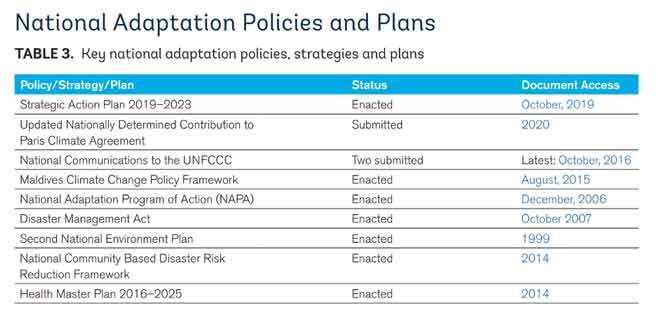
Maldives

On hearing the name “Maldives” the pictures of pristine white-sand beaches, turquoise blue oceans and lavish resorts immediately flash in mind. Popular amongst travellers as an exotic holiday destination, this Indian Ocean island-nation is an archipelago of 26 coral atolls covering a territory spread over roughly 90,000 square kilometres (sq. kms.). Almost 80 per cent of its whole area is nearly one metre or less above sea-level, and it is one of the earth’s most geographically dispersed countries. There are approximately 1192 low-lying islands in the Maldives, of which only about 187 are populated, thus making it Asia’s second-least populous country. The total land area of Maldives, which is around 298 sq. kms, corresponds with the usual area of a single middle-sized Western city, and hence is the smallest Asian nation.

In the globe, Maldives is the lowest country with an average ground level elevation of around 1.5 metres above sea-level, and is also the country with the lowest natural highest point of 2.4 metres.
Environmental Vulnerabilities in Maldives
Maldives has a fragile ecosystem. Although a global concern, Maldives is one of the world’s most vulnerable countries to Climate Change/Global Warming. Being a low-lying area, Maldives is faced with the issue of flooding. Plus, the threat of rising sea-levels adds an extra degree of vulnerability. Beach Erosion is a severe problem where land is being rapidly lost to the sea. Increasing coastal development with artificial constructions of harbours and long connecting bridges over the lagoons has led to the loosening of the beach soil, thus leading to erosion. Also, deforestation and escalating boating activities have resulted in the erosion of the beaches. Aminath Shauna, Maldives’ Minister of Environment, Climate Change and Technology stated that every year over 90% of the islands report flooding; about 97% suffer shoreline erosion, and almost 64% experience severe erosion. Extensive Coral Mining and Dredging for the development of shorelines and harbours, and other related activities ultimately leads to disruption in the natural ecosystem of the beaches. Natural and human-made degradation of the coral reef system has led to a crisis in Maldives. Jetty for accessing islands, inner lagoon dredging for harbour development, shoreline development, beach reclamation, reef blasting etc. disturbs the existing current movements and wave climate and ruins the habitat of many marine creatures. Loss of Natural Vegetation cover due to increasing artificial constructions, eventually damages the natural environment. Habitat loss and loss of Biodiversity happens majorly because of exploitation of the natural habitat for artificial and commercial purposes. Inadequate Sewage Treatment and faulty waste disposal mechanisms of the Maldives have made things difficult. There is inadequate space available for the dumping of solid and liquid wastes. Plastic waste has the most severe adverse effect on the environment in the Maldives. Around 21% of the total 855 metric tonnes of solid waste discarded daily in Maldives comes from the tourism industry. The junk on the islands contains many toxic chemicals that are extremely harmful for the bionetwork surrounding the islands and also affect human health. Sewage and liquid waste disposed on the island percolate through the aquifer and into the lagoon, leading to serious Water Pollution. Besides, it is projected that the freshwater supply of Maldives would be exhausted in the near future.
Maldivian Economy and Tourism
In the late 1960s, a team of experts from the United Nations Development Programme went to the Maldives and concluded their report on the prospects for tourism in the country. The first resort opened in 1972, and the tourism industry flourished since then. Presently there are 167 resorts, 782 hotels and guesthouses, and 158 safari vessels. In November 2019, the 1.5 millionth tourist arrived in the Maldives. Currently, there are roughly 164 islands which are ‘tourist resorts’ –the full island is a resort; only populated by tourists and resort staff.

Tourism and tourism-related sectors are the principal contributors to the economy and their importance continues to increase. In the pre-pandemic times, nearly 26% of their Gross Domestic Product (GDP) came from the tourism industry, and transport and communication (a tourism-related sector) contributed roughly 13% share of GDP in the Maldives. As per the Maldives Bureau of Statistics, resort employment stood at 44,954 in 2019, with nearly 47% of the total payroll employees being constituted by the locals.

The coastal and marine ecosystems are the asset base of the economy of Maldives. Tourism is based entirely on the health and attractiveness of the coastal features. Maldives is a popular tourist destination for adventure activities like diving, scuba diving, snorkelling, surfing etc. According to the Tourist Visitor Survey of 2019 conducted by the Ministry of Tourism of Maldives, the chief attractions in order of priority are the beaches, underwater beauty, peacefulness and small islands.
Tourism And Environment – The Complex Interdependence
There is a complicated relationship between tourism and the environment. On one hand, tourism enormously depends on environmental quality more than anything else. This holds especially significance for the Maldives. On the other hand, there can be severe impacts on the environment due to extreme pressure of tourist activities, as elaborated earlier. However, if done correctly, tourism can be made beneficial.
As an instance, fishing being one of the leading industries of the Maldivian economy, a vast number of tourists come to witness and also sometimes engage in fish-catching. This can be harmful to the environment if too many fish are caught and are not given enough time to replenish. Additionally tourists would not visit if there are no fishes left. Nonetheless, resort owners can employ the fishermen to escort tourists to see the fish instead of catching them and in the process pay the fishermen adequately. They would then, in turn, benefit the environment (less fish would be caught), tourism (more tourists would come to see fishes), and the society and economy (the workers would be paid more, and there would be more tourists).
Maldivian Governmental Efforts
As far as the national government’s actions are concerned, they have focussed on developing hard engineering solutions for over 20–25 years to tackle the issue. All the islands have protection from tidal swells, beach erosion prevention measures, harbour and shoreline safeguarding arrangements in place. At present, a net-zero policy has been initiated to shift from diesel to solar power; by 2023 single-use-plastic has been committed to be eliminated; also, the government is collaborating with the Asian Development Bank, World Bank and other development partners regarding important waste management projects. Along with promotion of ecotourism, the government policies promote resilience-building and health-guarding of the coral reefs. They have aimed safeguarding 20% of the ocean resources by 2030 to save the reefs, mangroves and other crucial biological zones of the republic.

“Our islands are slowly being inundated by the sea, one by one. If we do not reverse this trend, the Maldives will cease to exist by the end of this century…We are determined to be part of global solutions to reverse these trends, to change the status quo.”
-Ibrahim Mohamed Solih, Honourable President of the Republic of Maldives at the 26th Session of the Conference of the Parties to the United Nations Framework Convention on Climate Change
Glasgow, Scotland, November 01, 2021.
Latest data trends suggest that tourism in Maldives is rebounding as the country and the world as a whole is trying to bounce back from the COVID-19 pandemic. Nevertheless, for a small-island nation like Maldives which has minimal contribution to global climate change yet with an existential threat because of it, concerted action and committed support from all other countries is necessary.
The author is associated as a Consultant at the Indian Council for Research on International Economic Relations (ICRIER), New Delhi. Views expressed here are personal.
Saranya Sircar
Consultant at the Indian Council for Research on International Economic Relations (ICRIER), New Delhi
References:
1. https://www.maldivesembassy.be/en/about-maldives/geography-location
2. https://earthobservatory.nasa.gov/images/148158/preparing-for-rising-seas-in-the-maldives
3. https://statisticsmaldives.gov.mv/maldives-in-figures-june-2021/
4. https://www.maldivesembassy.be/en/about-maldives/geography-location
5. https://www.jstor.org/stable/41143441
6. https://www.theguardian.com/environment/2008/nov/11/climatechange-endangered-habitats-maldives
7. https://www.maldivesembassy.be/en/about-maldives/geography-location
8. https://www.imf.org/external/pubs/ft/fandd/2021/09/maldives-climate-change-aminath-shauna-trenches.htm
9. https://archive.tourism.gov.mv/downloads/tap/2012/Assessment_of_solid_waste_management_practices_and_its_vulnerability_to_climate_risks_in_maldives_tourism_sector.pdf
10. https://webunwto.s3.eu-west-1.amazonaws.com/s3fs-public/2021-11/Tourism%20Update%2027%20oct%20%281%29.pdf?iWPDwUVq1HS9NzFJE8byFWCbWEIrG_SZ=
11. https://www.unescap.org/sites/default/files/maldives_tsa_9-11dec2019.pdf
12. https://statisticsmaldives.gov.mv/maldives-in-figures-june-2021/
13. https://webunwto.s3.eu-west-1.amazonaws.com/s3fs-public/2021-11/Tourism%20Update%2027%20oct%20%281%29.pdf?iWPDwUVq1HS9NzFJE8byFWCbWEIrG_SZ=
14. https://www.undp.org/sites/g/files/zskgke326/files/publications/UNDP-MV-Rapid-Livelihood-Assessmentt-Impact-of-COVID-19-Crisis-in-the-Maldives-2020-full-report.pdf
15. http://statisticsmaldives.gov.mv/nbs/wp-content/uploads/2021/10/ResortEmployeeSurvey2020.pdf
16. https://webunwto.s3.eu-west-1.amazonaws.com/s3fs-public/2021-11/Tourism%20Update%2027%20oct%20%281%29.pdf?iWPDwUVq1HS9NzFJE8byFWCbWEIrG_SZ=
17. https://www.tourism.gov.mv/en/downloads/visitor_survey
18. https://yr11geoanita.weebly.com/environment.html
19. https://www.imf.org/external/pubs/ft/fandd/2021/09/maldives-climate-change-aminath-shauna-trenches.htm
20. https://www.adb.org/sites/default/files/publication/672361/climate-risk-country-profile-maldives.pdf
21. https://presidency.gov.mv/Press/Article/25643


